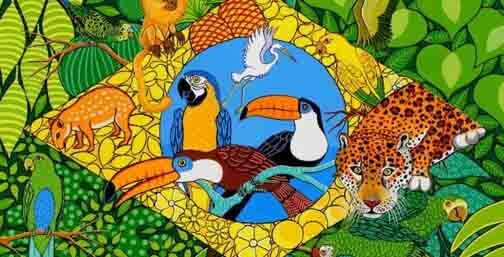Blog
The Unique Wild Animals of Brazil
- Wednesday November 16th, 2022
- Posted by: Amanda Ennes
- Category: Brazil

Brazil has one of the greatest biodiversity of any country on the planet. You can read more about that in our blog post Biodiversity in Brazil: A Megadiverse Country. Brazil is also the second country with the most endemic species in the world, home to an impressive wealth of animals. Some of the animals of Brazil include the hyacinth macaw, the giant anteater, and the green anaconda.
In this list below, we mention only a few of the thousand species of animals of Brazil. Check it out!
Table of Contents
ToggleAnta-brasileira (Brazilian tapir)
The Brazilian tapir has a fleshy, prehensile trunk, which the animals use to grasp objects such as leaves or act as a snorkel when they swim. The Brazilian tapir is the largest surviving terrestrial mammal in the Amazon, weighing around 200 kilograms and reaching up to 220 centimeters in length.
Arara-azul (Hyacinth macaw)
The Hyacinth macaw is the largest macaw and the largest flying parrot species. Its feathers are cobalt-blue and the ring around its eyes and the area underneath its beak is a vibrant yellow. The hyacinth macaw is an endangered species due to the cage bird trade and deforestation.
Ararajuba (Golden parakeet)
The golden parakeet is a medium-sized parrot, one of the endemic species of animals of Brazil. Its plumage is bright yellow with green in its outer wings. Just like the Hyacinth macaw, the Golden parakeet is also an endangered species due to the cage bird trade and deforestation.
Ariranha (Giant Brazilian otter)
The giant otter is a carnivorous mammal. It is a social species, with family groups typically supporting three to eight members. They have water-repellent fur, short legs, and a long tail to propel them through the water. Furthermore, their big eyes and long whiskers help them detect prey in the water.
Boto-cor-de-rosa (Amazon river dolphin)
The Amazon river dolphin transforms from grey to pink as it ages. The Amazon river dolphin, also called the pink river dolphin, is the largest of the river dolphin species, reaching up to 245 centimeters long and 200 kilograms. Moreover, they have powerful flippers and tail flukes and a modified hump in place of a dorsal fin.
Indigenous people believe Amazon river dolphins are magical creatures that are able to take the form of a handsome human man to seduce villagers late at night.
Capivara (Capybara)
The capybara is the largest living rodent in the world. They can be found in the Brazilian savanna and dense forests near bodies of water. It is a highly social species, usually living in groups of 10 to 20 individuals. The capybaras are semi-aquatic mammals, closely related to guinea pigs.
Fila Brasileiro (Brazilian Mastiff)
Even though the Brazilian Mastiff is not a wild animal, it is worth mentioning. The Brazilian Mastiff is a large working breed dog developed in Brazil. Because of their unique traits, they were primarily bred for being used as working and guard dogs, to protect cattle and plantations. It is known as Brazil’s national dog.
Jacu (Dusky-legged guan)
The Dusky-legged guan measures an average of 73 centimeters in length and weighs around 1.2 kilograms. They are a critical asset to tropical ecosystems because of their role in dispersing seeds in the forests. The Jacu coffee, one of the most expensive coffees in the world, is produced from beans collected from the feces of guans. These birds feast only on the very ripest coffee cherries produced in the forest shade. A bag containing 120 grams of Jacu coffee might cost around US$100.
Lobo-guará (Maned wolf)
The maned wolf is the largest canine in South America. It has long thin legs and a red coat. Its body is narrow and the ears are large and erect. Maned wolves are omnivorous and mostly inhabit the grasslands region of Brazil. The maned wolf is the picture of the newest R$200 bill in Brazil.
Mico-leão-dourado (Golden lion tamarin)
The golden lion tamarin, also called the golden marmoset, has thick golden-red fur, a long tail, and agile movements. They are endemic to the Atlantic Forest of Rio de Janeiro and are considered an endangered species due to the urbanization of the coastal area of Brazil. Additionally, the golden lion tamarin feeds on fruits, lizards, and insects.
Onça-pintada (South American jaguar)
The South American jaguar is one of the most famous animals of Brazil. They are the third-largest cat in the world, and also the strongest. 90% of the population of South American jaguars live in the Pantanal, hunting for caimans, anteaters, and capybaras. Unlike most other big cats, the South American jaguar is not averse to water — they are actually very good swimmers.
Peixe-Boi-da-Amazônia (Amazonian manatee)
The Amazonian manatee is an aquatic mammal that lives exclusively in freshwater environments, specifically the Brazilian Amazon. It currently features on the Brazilian Ministry of the Environment’s list as a species under threat of extinction. Hunters usually kill this animal for its abundant meat and oil. The Amazonian manatee is a herbivorous mammal, feeding exclusively on algae and aquatic plants. Nevertheless, the manatee can eventually weigh up to 300 kilograms and be as long as 2.5 meters.
Pica-pau-amarelo (Cream-colored woodpecker)
The cream-colored woodpecker is fairly common in the floodplain forest in the Amazon. They have pale creamy-yellow plumage, and sometimes brown feathers on their head and back. The cream-colored woodpecker feeds mainly on ants, termites, fruits, and seeds. The cream-colored woodpecker is famous in Brazil as the name for a popular series of fantasy novels by Brazilian author Monteiro Lobato, called Sítio do Pica-Pau Amarelo (The Yellow Woodpecker Ranch). These books have also been adapted into films and several TV shows, very popular in Brazil since 1977.
Sucuri (Green anaconda)
The green anaconda is the heaviest and one of the longest snake species in the world, reaching up to 5 meters long. These anacondas can be found in the basins of the main Brazilian rivers. Life in the water helps support the anaconda’s heavier weight and girth. This species is heavy and muscular. Moreover, they are nocturnal, terrestrial, aquatic, and non-venomous, feeding on birds, fishes, mammals, and reptiles. The digestion of a single meal can take two weeks or more.
Tamanduá-bandeira (Giant anteater)
The giant anteater has no teeth. However, their long tongues help them to lap up the ants and termites they eat. They often live in multiple habitats, including tropical and dry forests, savannas, and open grasslands. The giant anteater is not aggressive. However, when they are in danger, they rear up on their hind legs, using their tail for balance, and lash out with dangerous claws.
Tatu (Armadillo)
Armadillos are barrel-shaped animals covered with natural armor. Brazil holds ten species of armadillo in its territory, including the giant armadillo (tatu-canastra), the nine-banded armadillo (tatu-galinha), the Brazilian three-banded armadillo (tatu-bola), and the greater long-nosed armadillo (tatu-de-quinze-quilos). Most of these species are omnivores, feeding on plants, fruits, insects, and larvae. Most species dig burrows and sleep up to 16 hours per day.
Caminhos Language Centre is the largest and most exciting Portuguese school in Rio de Janeiro, Brazil. We have an excellent infrastructure, over 15 experienced Brazilian teachers, and a friendly multilingual support staff. We are the only school in Brazil able to offer Portuguese group courses throughout the year on 10 different levels. Moreover, our school also offers more than just Portuguese lessons for foreigners, we offer you the complete Rio de Janeiro experience. Every day we organize 100% free and fun activities for you to socialize and practice your Portuguese. We can also help you with a student visa for Brazil and accommodation in Rio de Janeiro.


 Deutsch
Deutsch Français
Français Português
Português Español
Español





